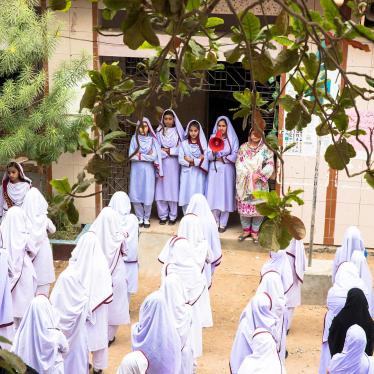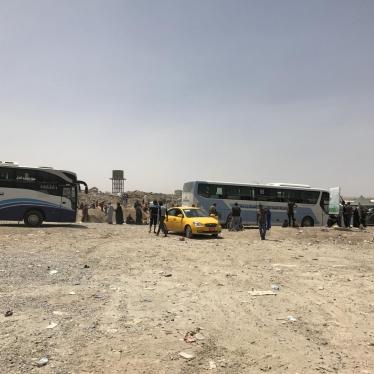(Kabul) -- The U.S. military should increase precautions and explain intelligence failures after two recent attacks caused the deaths of numerous civilians in Afghanistan, Human Rights Watch said today. In separate incidents, 15 children were killed by U.S. forces.
A U.S. military spokesman, while publicly regretting the loss of life, did not admit any wrongdoing on the part of the U.S. military in the attacks that resulted in the children's death. In discussing the first incident, which took place December 5, a U.S. military official placed responsibility on armed opposition forces for deploying forces in a residential area. The U.S. military said the "tragic incident" was being investigated.
"The U.S. military takes precautions to minimize civilian loss of life during its operations-but obviously not enough," said John Sifton, Afghanistan researcher for Human Rights Watch. "There is now a pattern of mistakes, apparently as a result of faulty intelligence, that has led to too many civilian deaths and no clear changes in the way the United States plans and carries out military operations."
The first incident took place on the night of December 5, in a rural village near Gardez, southeast of Kabul. Six children and two adults died under a collapsed wall after a U.S. air and ground attack on a compound used by an opposition militant to store weapons. The U.S. military knew as early as December 7 about the Gardez strike and the deaths, but only admitted the deaths on December 10 after being asked by a journalist about reports to that effect.
The second attack, reported before the first, took place at approximately 10:30 a.m. on December 6 in Hutala, southwest of Kabul. According to both villagers and the U.S. military, nine children were killed during the strike, along with one young man. According to journalists, villagers in Hutala described seeing two planes, later acknowledged to be A-10 attack planes (also known as "Warthogs") circling the area. Warthogs were primary designed to serve as anti-tank attack planes but can also be used to strafe infantry with high-speed machine guns and exploding shells.
According to villagers who spoke with journalists, one of the Warthogs circled back and opened fire over one house with its mounted machine guns. A journalist from the New York Times counted over 40 small craters, about half a meter in diameter, in the vicinity of the strike. The nine children killed, boys and girls from ages 9 to 12, were apparently in the line of fire just in front of a house that was the intended target of the strike. Journalists found small shoes, torn prayer caps and bloodstains on the ground, where villagers said the children had fallen and died.
According to journalists, the young man who was killed was named Abdul Mohammad, a recently returned refugee from Iran and not-as the U.S. military initially claimed-the intended target.
"In targeting a single house in order to attack a single person, it is unclear why such a heavy weapon was used," said Sifton. "The United States should reconsider the use of such weaponry in areas where there is clearly a considerable risk of civilian casualties."
Human Rights Watch stated that Taliban and other anti-U.S forces had in the past placed civilians at risk by attacking U.S. and Afghan government forces from residential areas. In all cases, the United States still must take special precautions when attacking areas in which civilians are known to be present. Human Rights Watch voiced doubt about the U.S. military's claim that it was unaware of civilians being present at the targeted locations. Civilians live within many of the areas in which the United States has conducted military operations. Villagers in one of the targeted areas said that the intended target, Mullah Wazir, had left two weeks before the attack on him took place.
"Stating that the U.S. military didn't know there were civilians present at these sites is simply not an adequate response," said Sifton. "The laws of war require that an attacking force take all feasible precautions to avoid civilian casualties. Even a cursory inquiry would have alerted U.S. forces to the civilian presence in the area."
Human Rights Watch called on the United States to review its methods of intelligence gathering and allow an independent international expert to investigate and report on the cause of these and other civilian casualties.
Under international humanitarian law, or the laws of war, armed forces cannot conduct attacks that cause harm to civilians or civilian objects that is excessive in relation to the anticipated military advantage of the attack. In cases where there is significant doubt as to whether a civilian object-for example, a house-is being used for military purposes, coalition forces are obligated to assume it is not.
Names and ages of the children killed: Habibullah, 11; Obaidullah, 10; Faizullah, 9; Ismail Jan, 11; Nabi Jan, 9; Habibullah, 12; Aminullah, 9; Bibi Toara, 10; and Bibi Tamama, 9.
According to Reuters, other incidents of civilian casualties caused by U.S forces since the fall of the Taliban in later 2001 include:
December 2001 - U.S. defense officials announced AC-130 gunships and Navy fighters attacked and destroyed a convoy in Afghanistan believed to be carrying leaders of the Taliban or al-Qaeda. But reports from the region said the convoy was carrying tribal elders and that about 65 people had been killed. The Pentagon rejected the reports.
December 31, 2001 - Villagers of Qalaye Niazi near Gardez in eastern Afghanistan said U.S. warplanes killed over 100 people. At least one fighter jet, a B-52 bomber and two helicopters swooped on the village.
July 2002 - The Afghan government said at least 48 people died and 117 were wounded when U.S. planes attacked a wedding party in the town of Deh Rawud in central Afghanistan. The U.S. military said a gunship had come under fire from the area.
February 2003 - U.S. bombing raids in the Baghran Valley area of the Helmand province killed 17 people, mostly women and children, according to locals.
February 2003 - Reports from locals said eight more civilians died in the Baghran Valley when a U.S. bomber and gunship attacked the area during operations against remnants of the Taliban.
April 2003 - Eleven Afghan civilians were killed, seven of them women, when a bomb dropped by coalition aircraft hit a house on the outskirts of Shkin near the Pakistan border, the U.S. military said.
September 2003 - At least eight civilians died in a U.S. air strike in the Naw Bahar district of the Zabul province that also killed a Taliban commander, a senior Afghan provincial official said.
October 2003 - Air strikes killed eight members of one family in the eastern province of Nuristan, according to local witnesses. Afghan officials said they presumed U.S. or allied warplanes were responsible.
November 2003 - Six Afghan civilians were killed in an aerial bombardment by U.S.-led forces hunting Islamic militants in the Barmal district of Paktika province, the governor said.






